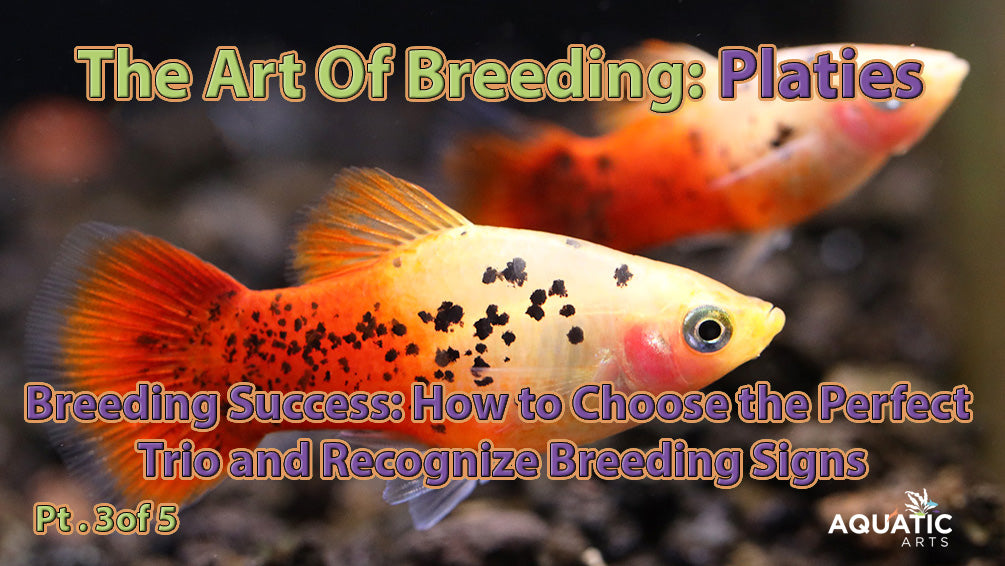Platy Breeding Success: How to Choose the Perfect Trio and Recognize Breeding Signs

Why the 1 Male to 2 Female Ratio Works Best
Selecting the right breeding Trio is essential for a successful and stress-free breeding environment. In this article, we’ll cover why a 1 male to 2 female ratio works best, how to identify males and females, and what signs to watch for as breeding begins. With a well-selected Trio, you’ll create a supportive space for breeding that encourages fry production and protects female Platies from excess attention.
Ready to support your pregnant Platy? The next article, Caring for Pregnant Platies and Getting Your Tank Fry-Ready, will cover pregnancy care and how to make the tank fry-safe.
Setting Up the Ideal Breeding Trio
Why This Ratio Works
A Trio setup (1 male, 2 females) is ideal because it reduces stress on the females. In a single-pair scenario, the female can become exhausted by the male’s attention, which can cause stress and health issues. By having two females, the male’s attention is shared, leading to a more natural, balanced breeding environment.
Identifying Males and Females
Male Platies are typically slimmer than females and have a pointed anal fin called the gonopodium. Females, on the other hand, have rounder bodies and lack this pointed fin. This difference makes it easier to spot and select fish for your breeding Trio.
Recognizing Breeding Behavior
Once your Trio is set, you’ll notice a few signs that breeding is underway. Male Platies will chase females and display behaviors like fin-flaring and intensified colors to attract the females’ attention. Once fertilized, a female’s belly will gradually round out, and a dark gravid spot near her rear fin will signal that fry are developing.
Q&A: Choosing a Platy Trio and Breeding Behavior
Q: Why is it important to have two females for each male?
A: It reduces stress on the females, promoting a healthier, more natural breeding process.
Q: How do I tell male and female Platies apart?
A: Males are usually slimmer with a pointed anal fin (gonopodium), while females are fuller-bodied.
Q: How can I tell if a female Platy is pregnant?
A: A rounded belly and a dark “gravid spot” near the rear fin indicate pregnancy.
Q: How often do Platies breed?
A: Platies can breed every 4-6 weeks, with each pregnancy lasting around 28 days.
Q: Can I keep more than one Trio in a tank?
A: Yes, but ensure you have a large enough tank (20 gallons or more) to reduce crowding.
Q: Do Platies show specific breeding behaviors?
A: Males may chase females and display fin-flaring when ready to breed.
Q: How many fry does a female Platy typically have?
A: A female can have 20–50 fry, depending on her size and health.
Q: Should I separate breeding Platies from other tankmates?
A: It’s a good idea to use a dedicated tank or create safe spaces if they’re in a community tank.
Q: What should I feed my breeding Platies?
A: A mix of flakes, freeze-dried, and live foods supports their health and breeding success.
Q: How can I prevent overcrowding if I have multiple breeding Trios?
A: Regularly separate some fry or consider a larger tank to manage population.
With a well-selected Trio and a supportive environment, your Platies will soon be ready to welcome a new generation! Now that you know what to expect from the breeding pair, it’s time to focus on caring for your pregnant Platy and preparing for fry. Our next post will guide you through the signs of pregnancy, special care for expecting females, and tips to get your tank ready for Platy fry.
Check out the full series in order below:
Blog 1: Why Platies Are a Beginner Breeder’s Dream Fish
Blog 2: Platy Breeding Tank Setup Made Simple: Essentials for Success
Blog 3: How to Care for Pregnant Platies and Get Your Tank Fry-Ready
Blog 4: Raising Platy Fry and Creating a Thriving Breeding Program




